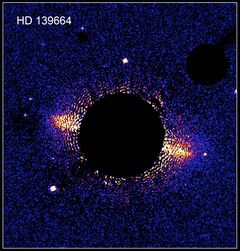Astronomy:HD 139664
| Observation data Equinox J2000.0]] (ICRS) | |
|---|---|
| Constellation | Lupus |
| Right ascension | 15h 41m 11.3774s[1] |
| Declination | −44° 39′ 40.338″[1] |
| Apparent magnitude (V) | 4.64[2] |
| Characteristics | |
| Spectral type | F3/5V[3] |
| U−B color index | −0.03[4] |
| B−V color index | +0.413[2] |
| R−I color index | +0.20[4] |
| Astrometry | |
| Radial velocity (Rv) | −7.08±0.03[2] km/s |
| Proper motion (μ) | RA: −168.70[1] mas/yr Dec.: −265.69[1] mas/yr |
| Parallax (π) | 57.09 ± 0.72[1] mas |
| Distance | 57.1 ± 0.7 ly (17.5 ± 0.2 pc) |
| Absolute magnitude (MV) | 3.57[5] |
| Details[6] | |
| Mass | 1.368±0.026[2] M☉ |
| Radius | 1.26[7] R☉ |
| Luminosity | 3.31 L☉ |
| Surface gravity (log g) | 4.29 cgs |
| Temperature | 6,704±63 K |
| Rotational velocity (v sin i) | 71.6[2] km/s |
| Age | 1.11±1.40 Gyr |
| Other designations | |
| Database references | |
| SIMBAD | data |
HD 139664 is a single[9] star in the southern constellation of Lupus. It has the Bayer designation g Lupi; HD 139664 is the star's identifier from the Henry Draper Catalogue.[8] It has a yellow-white hue and is visible to the naked eye with an apparent visual magnitude of 4.64. The star is located at a distance of 57 light years from the Sun based on parallax,[1] and it is drifting closer with a radial velocity of −7 km/s.[2] It is a member of the Hercules-Lyra Association of co-moving stars.[10][2]
This is an F-type main-sequence star with a stellar classification of F3/5V,[3] which indicates it is generating energy through core hydrogen fusion. The estimated age is poorly constrained at around one billion years,[6] but the age of the Hercules-Lyra Association to which it belongs is 257±46 million years.[11] It has a moderately high rate of spin, showing a projected rotational velocity of 71.6 km/s.[2] The star has 1.37[2] times the mass of the Sun and 1.26[7] times the Sun's radius. It is radiating 3.31 times the luminosity of the Sun from its photosphere at an effective temperature of 6,704 K.[6]
Debris disk
A debris disk has been imaged around this star using the coronagraphic mode of the ACS instrument on the Hubble Space Telescope. The disk appears to have a dust maximum at 83 AU from the star and a sharp outer boundary at 109 AU. These features may be caused by gravitational perturbations from planets orbiting the star.[12]
References
- ↑ 1.0 1.1 1.2 1.3 1.4 1.5 van Leeuwen, F. (November 2007), "Validation of the new Hipparcos reduction", Astronomy and Astrophysics 474 (2): 653–664, doi:10.1051/0004-6361:20078357, Bibcode: 2007A&A...474..653V.
- ↑ 2.0 2.1 2.2 2.3 2.4 2.5 2.6 2.7 2.8 Desidera, S. et al. (January 2015), "The VLT/NaCo large program to probe the occurrence of exoplanets and brown dwarfs in wide orbits. I. Sample definition and characterization", Astronomy & Astrophysics 573: 45, doi:10.1051/0004-6361/201323168, A126, Bibcode: 2015A&A...573A.126D.
- ↑ 3.0 3.1 Houk, Nancy (1978), Michigan catalogue of two-dimensional spectral types for the HD stars, 2, Ann Arbor: Dept. of Astronomy, University of Michigan, Bibcode: 1978mcts.book.....H.
- ↑ 4.0 4.1 Hoffleit, D.; Warren, W. H. Jr., "HR 5825, database entry", The Bright Star Catalogue, http://webviz.u-strasbg.fr/viz-bin/VizieR-5?-out.add=.&-source=V/50/catalog&recno=5825, retrieved February 4, 2011
- ↑ Reiners, Ansgar (January 2006), "Rotation- and temperature-dependence of stellar latitudinal differential rotation", Astronomy and Astrophysics 446 (1): 267–277, doi:10.1051/0004-6361:20053911, Bibcode: 2006A&A...446..267R
- ↑ 6.0 6.1 6.2 Luck, R. Earle (March 2018), "Abundances in the Local Region. III. Southern F, G, and K Dwarfs", The Astronomical Journal 155 (3): 31, doi:10.3847/1538-3881/aaa9b5, 111, Bibcode: 2018AJ....155..111L.
- ↑ 7.0 7.1 Rhee, Joseph H. et al. (May 2007), "Characterization of Dusty Debris Disks: The IRAS and Hipparcos Catalogs", The Astrophysical Journal 660 (2): 1556–1571, doi:10.1086/509912, Bibcode: 2007ApJ...660.1556R.
- ↑ 8.0 8.1 "g Lup". SIMBAD. Centre de données astronomiques de Strasbourg. http://simbad.u-strasbg.fr/simbad/sim-basic?Ident=g+Lup.
- ↑ Halbwachs, J. -L et al. (2018), "Multiplicity among solar-type stars. IV. The CORAVEL radial velocities and the spectroscopic orbits of nearby K dwarfs", Astronomy and Astrophysics 619: A81, doi:10.1051/0004-6361/201833377, Bibcode: 2018A&A...619A..81H.
- ↑ Lopez-Santiago, J. et al. (2006), "The Nearest Young Moving Groups", The Astrophysical Journal 643 (2): 1160–1165, doi:10.1086/503183, Bibcode: 2006ApJ...643.1160L.
- ↑ Eisenbeiss, T. et al. (August 2013), "The Hercules-Lyra association revisited. New age estimation and multiplicity study", Astronomy & Astrophysics 556: 19, doi:10.1051/0004-6361/201118362, A53, Bibcode: 2013A&A...556A..53E.
- ↑ Kalas, Paul et al. (January 2006), "First Scattered Light Images of Debris Disks around HD 53143 and HD 139664", The Astrophysical Journal 637 (1): L57–L60, doi:10.1086/500305, Bibcode: 2006ApJ...637L..57K, https://cds.cern.ch/record/923790.
 |


